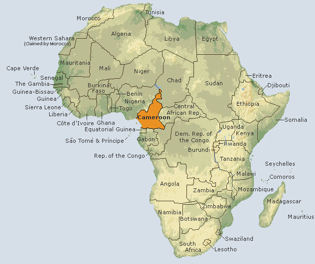A Mancala Board called "Songo"
Major P.H.G. Powell-Cotton
Man, No.132-133, July 1931, page 123.

Note: The photograph indicated below as Plate D is not available for inclusion in this Webpage.
[Page 123] The board figured in Plate D. came in 1929 from the M'Velle East Country, to the East of Yaounde, French Cameroons. It measures 33½ inches by 7½ inches and stands 8½ inches high. It is formed of four mid-ribs of palm leaf lashed together with cross pieces above and below at the ends, with four rough hard wooden legs, secured by a peg which passes through each outer rib and its cross pieces. About a quarter of each side is split off to make a flat surface. In the two centre ribs this flat surface is uppermost. Each has seven compartments cut in it 3 inches to 4 inches long and 1½ inches wide. The two outer rips have the flat side downwards.
With this and similar boards, the game of Songo was being played in the M'VeIle East country, September, 1929. The M'Velle tribe occupies the country N.E. of Yaounde, French Cameroons.
The board has fourteen compartments, seven on each side; 5 beans (often, as in this case, small stones are used) are placed in each, totalling 70.
There are two players, one on each side. The players alternately pick up all the beans from any compartment on their side, and drop them consecutively one in each, commencing with the compartment next to (and on the left of) the one from which the beans are taken. If there are sufficient beans, this is continued along the opponent's side till they are exhausted.
The object of each move is to complete a previously determined number with the last bean of a round dropped in a compartment on the opponent's side. The number is usually 2 or 4; or 3 or 4; but 2, 3, or 4 is also played to make a shorter game. That is to say, the last bean played should fall in a compartment which already contains 1 or 3; 2 or 3; or 1, 2 or 3 beans, according to the method agreed on.
When one of the agreed numbers has been made in an opponent's compartment the player not only takes the beans in it, but also those in the compartment on either side of it or consecutive to it, which then contain a similar number. The player who has no more beans on his side, when it is his turn to play, is the loser.
The Balanga people play with only four compartments on each side of the Songo board; Duala people play with seven compartments as in M'Velle, and with eight beans instead of five per compartment.
Editorial Note by H. J. Braunholtz
This account agrees closely with that given for the same region by G. Tessmann in "Die Pangwe" (1912), Vol. II, p. 310, and his fig. 115 illustrates a board almost identical with this one. He states that captures are effected by making up to either 2, 3 or 4 with the last bean played, and that only the preceding holes containing these numbers arc captured, not those on either side of the one in which the last bean is dropped.
This rule of capturing from preceding holes as well as from that in which the last bean is dropped, if they contain (in this case) either twos or threes, also holds good for the form of wari described by G. T. Bennett in Rattray's "Religion and Art in Ashanti" (1927), p. 382 ff.
This game (says Tessmann) is played by the Yaunde and Bene (who learned it from tribes further East), and more rarely by the Ntum and 'Fang; the name Songo means "small pebbles." i.e., the pieces used by the players.
Last update January 8, 2010
